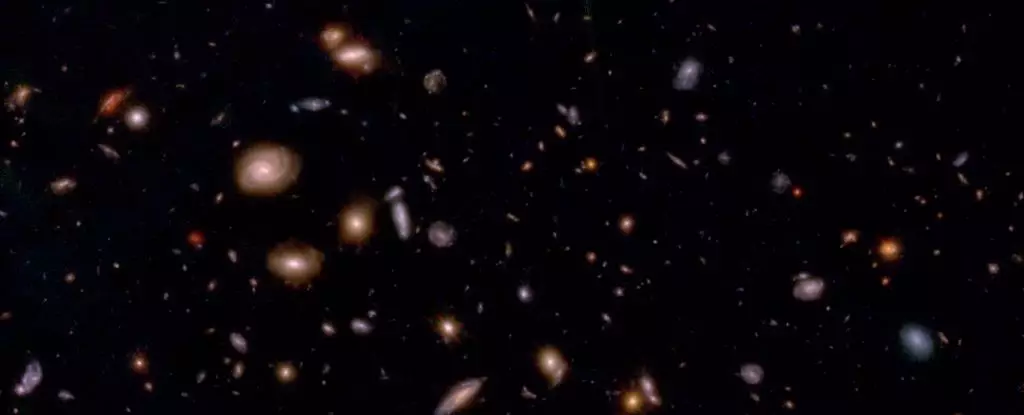When we gaze into the vast unknowns of the universe, awe and curiosity often collide. The cosmos presents a vivid reminder of both our insignificance and our potential for discovery. Recent astronomical surveys have revealed an intriguing phenomenon: galaxies predominantly rotate in a uniform direction, defying expectations set by our current cosmological models. This notable rotational alignment poses an existential question: is our understanding of the universe fundamentally flawed? As we continue peeling back the layers of cosmic existence, we find ourselves grappling with new interpretations that may reshape our conceptual framework of the cosmos.
Understanding the Rotational Conundrum
The prevailing belief in cosmology holds that galaxies should display random rotational behaviors—each spinning in different directions like nimble dancers in a chaotic ballet. Contrarily, Lior Shamir, an astronomer at Kansas State University, sheds light on a puzzling skewness in galaxy spin distributions. His insights reveal a compelling dichotomy, hinting at a deeper, perhaps unsettling truth about our universe’s origins and configuration.
In his research, Shamir observed that, rather than a 50-50 distribution of clockwise and counterclockwise spins, a significant asymmetry exists. Out of 263 observed galaxies, 158 display clockwise rotation while only 105 spin counterclockwise. Such an imbalance suggests that our universe may not be as isotropic—the principle that the universe appears uniform no matter the direction one looks—as long believed.
Galactic Origins: Birth of a Cosmic Theory
The implications of these findings are staggering. The most radical hypothesis presented by Shamir is that the universe may have itself been born with a rotation. This theory aligns with black hole cosmology, which posits that our entire universe could exist within a gigantic black hole. While such a notion seems outlandish, it challenges us to reconsider the very fabric of our reality. Could our fundamental models be incomplete, shaping a narrative that oversimplifies the intricacies of cosmic evolution?
However, not all interpretations are as compelling. Another explanation posits that the peculiar rotation could stem from observational biases tied to the rotation of our own Milky Way galaxy. If this were true, it would suggest that part of the asymmetry we observe might be an illusion created by our position in space. Such a view, while less thrilling, calls for a reassessment of our distance measurements and the methodologies we use to analyze cosmic phenomena.
The Role of Dark Matter: A Cosmic Web
As we delve deeper into Shamir’s findings, we uncover the existence of intricate structures within the universe that guide galactic behavior. Vast filaments of dark matter create a gravitational web that shores up galaxy clusters. This web provides a unified framework of gravitational interconnection that was previously underappreciated, suggesting that perhaps our understanding of dark matter and its influence on cosmic architecture warrants reevaluation.
According to Shamir, if the movement of galaxies is influenced by these vast structures, their spins should essentially showcase a randomized pattern. The persistent asymmetry contradicts this assumption, lending credence to the idea that darker forces underlie the visible universe. This conundrum opens the door to further investigations into gravitational webs and the mechanics governing galaxy formation and behavior across cosmic time.
The Cost of Reluctance: Stagnation in Cosmic Understanding
One cannot help but consider the ramifications of clinging to outdated models in light of evidence suggesting a more complex reality. The scientific community must remain unyielding in its exploration of new paradigms, even when it challenges long-standing beliefs. This inquiry is particularly crucial considering the accelerating expansion of the universe—a phenomenon that has already reignited debates surrounding dark energy and the cosmos’ ultimate fate.
Shamir’s meticulous research underscores the importance of robust inquiry and adaptability within scientific disciplines. As new technologies—like the James Webb Space Telescope (JWST)—offer unparalleled views of the universe, the opportunity to question assumptions broadens exponentially. Transparency in how we interpret data collected from these astronomical tools is vital to advancing our understanding.
In the face of uncertainty, it’s imperative to prioritize curiosity over conformity as we explore the cosmos. The evidence is there, eagerly awaiting our attentive scrutiny, and invites us to reconsider everything we thought we knew about the universe. To embrace the possibility that we tread a pathway of uncertainty, enriched by the thrill of discovery, may be exactly what is required to push the boundaries of our cosmic comprehension.

